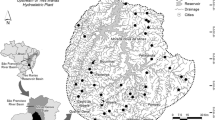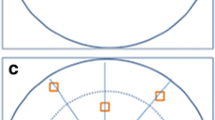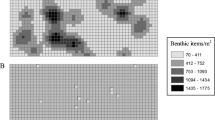Abstract
Monitoring forms the basis for understanding ecological change. It relies on repeatability of methods to ensure detected changes accurately reflect the effect of environmental drivers. However, operator bias can influence the repeatability of field and laboratory work. We tested this for invertebrates and diatoms in three trials: (1) two operators swept invertebrates from heath vegetation, (2) four operators picked invertebrates from pyrethrum knockdown samples from tree trunk and (3) diatom identifications by eight operators in three laboratories. In each trial, operators were working simultaneously and their training in the field and laboratory was identical. No variation in catch efficiency was found between the two operators of differing experience using a random number of net sweeps to catch invertebrates when sequence, location and size of sweeps were random. Number of individuals and higher taxa collected by four operators from tree trunks varied significantly between operators and with their ‘experience ranking’. Diatom identifications made by eight operators were clustered together according to which of three laboratories they belonged. These three tests demonstrated significant potential bias of operators in both field and laboratory. This is the first documented case demonstrating the significant influence of observer bias on results from invertebrate field-based studies. Examples of two long-term trials are also given that illustrate further operator bias. Our results suggest that long-term ecological studies using invertebrates need to be rigorously audited to ensure that operator bias is accounted for during analysis and interpretation. Further, taxonomic harmonisation remains an important step in merging field and laboratory data collected by different operators.




Similar content being viewed by others
References
Azarbayjani, F. F., & Richardson, B. J. (1999). Monitoring for changes in arboreal arthropod biodiversity in woodlands: how many replicates are needed? In W. Ponder & D. Lunney (Eds.), The conservation and biodiversity of invertebrates. The other 99% (pp. 40–45). Mosman: Transactions of the Royal Zoological Society of New South Wales.
Bate, N., & Newall, P. (1998). Techniques for the use of diatoms in water quality assessment: how many valves? Proceedings of the 15th international symposium. Ruggell: ARG Gantner.
Battarbee, R. W. (1994). Diatoms, lake acidification and the surface water acidification programme (SWAP): a review. Hydrobiologia, 274(1), 1–7.
Battarbee, R. W., Jones, V. J., Flower, R. J., et al. (2001). Diatoms: tracking environmental change using lake sediments. In J. P. Smol, H. J. B. Birks, & W. M. Last (Eds.), Volume 3: terrestrial, algal, and siliceous indicators (pp. 155–202). Drodrecht: Kluwer Academic Publishers.
Charles, D. F., Smol, J. P., & 6.2. (1988). New methods for using diatoms and chrysophytes to infer past pH of low-alkalinity lakes. Limnology and Oceanography, 33, 1451–1462. The American Society of Limnology and Oceanography, Inc.
Dajani, M. A. Z., & 5. (2015). The impact of employee engagement on job performance and organisational commitment in the Egyptian banking sector. Journal of Business and Management Sciences, 3, 138–147. doi:10.12691/jbms-3-5-1.
Diefenbach, D. R., Brauning, D. W., & Mattice, J. A. (2003). Variability in grassland bird counts related to observer differences and species detection rates. The Auk, 120, 1168–1179. doi:10.1642/0004-8038(2003)120[1168:VIGBCR]2.0.CO;2.
Dreber, A., Pfeiffer, T., & Almenberg, T. J. (2015). Using prediction markets to estimate the reproducibility of scientific research. PNAS, 112(50), 15343–15347. doi:10.1073/pnas.1516179112.
Fitzpatrick, M. C., Preisser, E. L., Ellison, A. M., & Elkinton, J. S. (2009). Observer bias and the detection of low-density populations. Ecological Applications, 19(7), 1673–1679. doi:10.1809/09-0265.1.
Fraser, H., Garrard, G. E., Rumpff, L., et al. (2015). Consequences of inconsistently classifying woodland birds. Frontiers in Ecology and Evolution, 3, 1–8. doi:10.3389/fevo.2015.00083.
Gell, P. A., Sluiter, I. R., & Fluin, J. (2002). Seasonal and inter-annual variations in diatom assemblages in Murray River-connected wetlands in northwest Victoria, Australia. Marine and Freshwater Research, 53, 981–992.
Gray, G. (2015). Why did thalidomide’s makers ignore warnings about their drug? The Conservation, December 8th.
Janzen, D. H., & Pond, C. M. (1975). A comparison, by sweep sampling, of the arthropod fauna of secondary vegetation in Michigan, England and Costa Rica. Transactions of the Royal Entomological Society, London, 127(1), 33–50.
Krammer, K., & Lange-Bertalot, H. (1986). Susswasserflora von Mitteleuropa. Bacillariophyceae Teil i: Naviculaceae. Stuttgart: Gustav Fischer Verlag, p. 876.
Krammer, K., & Lange-Bertalot, H. (1988). Susswasserflora von Mitteleuropa. Bacillariophyceae Teil ii: Bacillariaceae, Epithemiaceae, Surirellaceae. Stuttgart: Gustav Fischer Verlag, p. 576.
Krammer, K., & Lange-Bertalot, H. (1991a). Susswasserflora von Mitteleuropa. Bacillariophyceae Teil iii: Centrales, Fragilariaceae, Eunotiaceae. Stuttgar: Gustav Fischer Verlag, p. 596.
Krammer, K., & Lange-Bertalot, H. (1991b). Susswasserflora von Mitteleuropa. Bacillariophyceae Teil iv: Achnanthaceae. Stuttgart: Gustav Fischer Verlag, p. 437.
Krammer, K., & Lange-Bertalot, H. (1997). Susswasserflora von Mitteleuropa. Bacillariophyceae Teil ii: Bacillariaceae, Epithemiaceae, Surirellaceae. Stuttgart: Gustav Fischer Verlag.
Link, W. A., & Sauer, J. R. (1997). New approaches to the analysis of population trends in land birds: a comment on statistical methods. Ecology, 78, 2632–2634.
Lotz, A., & Allen, C. R. (2007). Observer bias in anuran call surveys. Journal of Wildlife Management, 71(2), 675–679. doi:10.2193/2005-759.
McDonald-Madden, E., Baxter, P. W. J., & Fuller, R. A. (2010). Monitoring does not always count. Cell Press. Special Issue: Long-Term Ecological Research, 25(10), 547–550. doi:10.1016/j.tree.2010.07.002.
Melbourne, B. A. (1999). Bias in the effect of habitat structure on pitfall traps: an experimental evaluation. Australian Journal of Ecology, 24, 238–239.
Smol, J. P., & Stoermer, E. F. (2010). The diatoms: applications for the environmental and earth sciences. Cambridge: Cambridge University Press.
Southwood, T. R. E. (1978). Ecological methods. London: Chapman and Hall.
Tibby, J., Reid, M. A., Fluin, J., Hart, B. T., & Kershaw, A. P. (2003). Assessing long-term pH change in an Australian river catchment using monitoring and palaeolimnological data. Environmental Science and Technology, 37(15), 3250–3255.
Upton, M. T., & Norris, K. R. (1980). The collection and preservation of insects and other terrestrial arthropods. Brisbane: Australian Entomological Society.
Acknowledgments
Thanks are due to Tasmanian Parks and Wildlife Service for the permission to collect in the World Heritage Area in 1992 and 1996 and to all those, too numerous to mention, who took part in the studies reported here.
Author information
Authors and Affiliations
Corresponding author
Electronic supplementary material
Below is the link to the electronic supplementary material.
Supplementary data 1
(DOCX 18 kb)
Supplementary data 2
(DOCX 18 kb)
Supplementary data 3
(DOCX 22 kb)
Supplementary data 4
(DOCX 17 kb)
Supplementary data 5
(DOCX 17 kb)
Rights and permissions
About this article
Cite this article
Greenslade, P., Florentine, S.K., Hansen, B.D. et al. Biases encountered in long-term monitoring studies of invertebrates and microflora: Australian examples of protocols, personnel, tools and site location. Environ Monit Assess 188, 491 (2016). https://doi.org/10.1007/s10661-016-5478-x
Received:
Accepted:
Published:
DOI: https://doi.org/10.1007/s10661-016-5478-x




